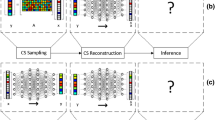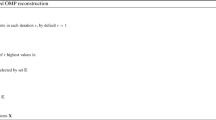Abstract
Cognitive radio requires spectrum sensing over a broad frequency band and leads to a high sampling rate. In this paper, we propose an asynchronous coprime sampling technique for capturing and reconstructing of sparse multiband signals that occupy a small part of a given broad frequency band. The band locations of signal are not known a priori. In this proposed approach, we use a sub-Nyquist sampling rate by exploiting a low-dimensional representation of the original high-dimensional signal. A common input sparse multiband signal is digitized using a pair of uniform samplers, which are (not necessarily synchronously) clocked at coprime sampling rates. The captured samples are then re-sequenced and the multi-coset signal processing algorithm is employed. We derive the system model in the frequency domain, where the phase mismatch is compensated. Compared to the conventional multi-coset sampling, the proposed approach needs fewer samplers and does not require synchronous clock phase. Simulation results are provided to demonstrate the feasibility and effectiveness of the proposed asynchronous coprime sampling for sparse multiband signal.








Similar content being viewed by others
References
Mitola, J.: Cognitive radio for flexible mobile multimedia communications. In: Proceedings on (MoMuC’99) IEEE International Mobile Multimedia Communication Workshop, pp. 3–10 (1999)
McHenry, M.: NSF spectrum occupancy measurements project summary. Shared Spectrum Co., Vienna (2005)
Jiang, J., Sun, H., Baglee, D., Poor, V.: Achieving autonomous compressive spectrum sensing for cognitive radios. IEEE Trans. Veh. Technol. 65(3), 1281–1291 (2016)
Clemencio, F.M.C., Loureiro, C.F.M., Correia, C.M.B.: An easy procedure for calibrating data acquisition systems using interleaving. IEEE Trans. Nucl. Sci. 54(4), 1227–1231 (2007)
Ivchenko, V.G., Kalashnikov, A.N., Challis, R.E., Hayes-Gill, B.R.: High-speed digitizing of repetitive waveforms using accurate interleaved sampling. IEEE Trans. Instrum. Meas. 56(4), 1322–1328 (2007)
Donoho, D.: Compressed sensing. IEEE Trans. Inform. Theory 52, 1289–1306 (2006)
Candès, E., Romberg, J., Tao, T.: Robust uncertainty principles: exact signal reconstruction from highly incomplete frequency information. IEEE Trans. Inform. Theory 52(2), 489–509 (2006)
Duarte, M.F., Baraniuk, R.G.: Spectral compressive sensing. Appl. Comput. Harmonic Anal. 35(1), 111–129 (2013)
Shi, G., Lin, J., Chen, X., Qi, F., Liu, D., Zhang, L.: UWB echo signal detection with ultra-low rate sampling based on compressed sensing. IEEE Trans. Circuits Syst. II 55(4), 379–383 (2008)
Kirolos, S., Laska, J., Wakin, M., Duarte, M., Baron, D., Ragheb, T., Massoud, Y., Baraniuk, R.: Analog-to-information conversion via random demodulation. In: Proceedings on IEEE Dallas Circuits System Workshop (DCAS), Dallas, TX, pp. 71–74 (2006)
Tropp, J.A., Laska, J.N., Duarte, M.F., Romberg, J.K., Baraniuk, R.G.: Beyond Nyquist: efficient sampling of sparse bandlimited signals. IEEE Trans. Inform. Theory 56(1), 520–544 (2010)
Mangia, M., Rovatti, R., Setti, G.: Rakeness in the design of analog-to-information conversion of sparse and localized signals. IEEE Trans. Circuits Syst. I 59(5), 1001–1014 (2012)
Mishali, M., Eldar, Y.C.: From theory to practice: sub-Nyquist sampling of sparse wideband analog signals. IEEE J. Sel. Top. Signal Process. 4(2), 375–391 (2010)
Mishali, M., Eldar, Y.C., Dounaevsky, O., Shoshan, E.: Xampling: analog to digital at sub-Nyquist rates. IET Circuits Devices Syst. 5(1), 8–20 (2011)
Haque, T., Yazicigil, R.T., Pan, K.J.L., Wright, J., Kinget, P.R.: Theory and design of a quadrature analog-to-information converter for energy-efficient wideband spectrum sensing. IEEE Trans. Circuits Syst. I 62(2), 527–535 (2015)
Zhao, Y., Hu, Y.H., Wang, H.: Enhanced random equivalent sampling based on compressed sensing. IEEE Trans. Instrum. Meas. 61(3), 579–586 (2012)
Zhao, Y., Hu, Y.H., Liu, J.: Random triggering-based sub-Nyquist sampling system for sparse multiband signal. IEEE Trans. Instrum. Meas. 66(7), 1789–1797 (2017)
Bai, L., Roy, S.: Compressive spectrum sensing using a bandpass sampling architecture. IEEE J. Emerg. Sel. Top. Circuits Syst. 2(3), 433–442 (2012)
Fleyer, M., Linden, A., Horowitz, M., Rosenthal, A.: Multirate synchronous sampling of sparse multiband signals. IEEE Trans. Signal Process. 58(3), 1144–1156 (2010)
Tzou, N., Bhatta, D., Muldrey Jr., B., Moon, T., Wang, X., Choi, H., Chatterjee, A.: Low cost sparse multiband signal characterization using asynchronous multi-rate sampling: algorithms and hardware. J. Electron. Test. 31(1), 85–98 (2015)
Sun, H., Chiu, W.Y., Jiang, J., Nallanathan, A., Poor, H.V.: Wideband spectrum sensing with sub-Nyquist sampling in cognitive radios. IEEE Trans. Signal Process. 60(11), 6068–6073 (2012)
Venkataramani, R., Bresler, Y.: Optimal sub-Nyquist nonuniform sampling and reconstruction for multiband signals. IEEE Trans. Signal Process. 49(10), 2301–2313 (2001)
Krieger, J., Kochman, Y., Wornell, G.: Design and analysis of multi-coset arrays. In: IEEE International Conference on Acoustics, Speech and Signal Processing (ICASSP), pp. 3781–3785 (2013)
Weng, Z., Djuric, P.M.: A search-free DOA estimation algorithm for coprime arrays. Digit. Signal Process. 24(1), 27–33 (2014)
Vaidyanathan, P.P., Pal, P.: Sparse sensing with co-prime samplers and arrays. IEEE Trans. Signal Process. 59(2), 573–586 (2011)
Scharf, L.L.: Statistical Signal Processing: Detection, Estimation, and Time Series Analysis. Addison-Wesley Publishing Co., Reading (1991)
Mishali, M., Eldar, Y.C.: Blind multiband signal reconstruction: compressed sensing for analog signal. IEEE Trans. Signal Process. 57(3), 993–1009 (2009)
Yousif, A.S., Haslett, J.W.: A fine resolution TDC architecture for next generation PET imaging. IEEE Trans. Nucl. Sci. 54(5), 1574–1582 (2007)
Bresler, Y.: Spectrum-blind sampling and compressive sensing for continuous-index signals. In: Information Theory and Applications Workshop IEEE, pp. 547–554 (2008)
Abdulhay, E., Mohammed, M.A., Ibrahim, D.A., Arunkumar, N., Venkatraman, V.: Computer aided solution for automatic segmenting and measurements of blood leucocytes using static microscope images. J. Med. Syst. (2018). https://doi.org/10.1007/s10916-018-0912-y
Liu, C., Arunkumar, N.: Risk prediction and evaluation of transnational transmission of financial crisis based on complex network. Clust. Comput. (2018). https://doi.org/10.1007/s10586-018-1870-3
Arunkumar, N., Kumar, K.R., Venkataraman, V.: Automatic detection of epileptic seizures using new entropy measures. J. Med. Imaging Health Info. 6(3), 724–730 (2016)
Stephygraph, L.R., Arunkumar, N.: Brain-actuated wireless mobile robot control through an adaptive human-machine interface. Adv. Intell. Syst. Comput. 397, 537–549 (2016)
Malarkodi, M.P., Arunkumar, N., Venkataraman, V.: Gabor wavelet based approach for face recognition. Int. J. Appl. Eng. Res. 8(15), 1831–1840 (2013)
Acknowledgements
National Natural Science Foundation of China (Grant No. 61671114).
Author information
Authors and Affiliations
Corresponding author
Appendix 1
Appendix 1
1.1 Real-valued signals
In this Appendix, we present the modifications to (12) for real-valued signal reconstruction. The sparse multiband signal is required to be bandlimited to ℱ ⊂ [−1/(2T), 1/(2T)]. The FT is conjugate symmetric for a real-valued signal x(t), its FT X(f) contains positive and negative frequencies. To form x(f), ℱ is still equally partitioned into L frequency intervals. Then, for odd and even values of L, ℱ0 is redefined by
Define the set of L consecutive integers:
Consequently, x(f) is rewritten as
where 0 ≤ l < L. The (i, l)th entry of Φ is given by
Rights and permissions
About this article
Cite this article
Zhao, Y., Xiao, S. Sparse multiband signal spectrum sensing with asynchronous coprime sampling. Cluster Comput 22 (Suppl 2), 4693–4702 (2019). https://doi.org/10.1007/s10586-018-2297-6
Received:
Revised:
Accepted:
Published:
Issue Date:
DOI: https://doi.org/10.1007/s10586-018-2297-6




